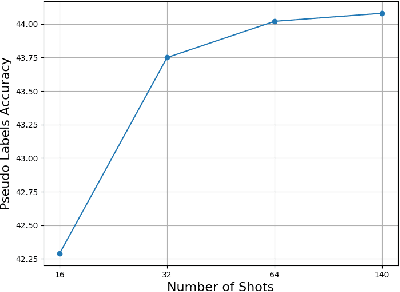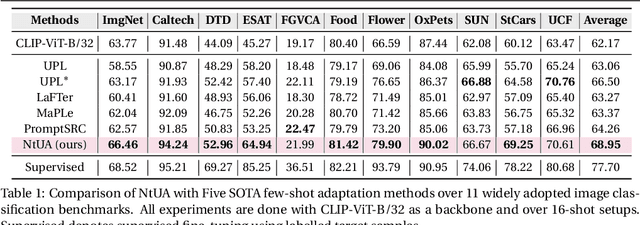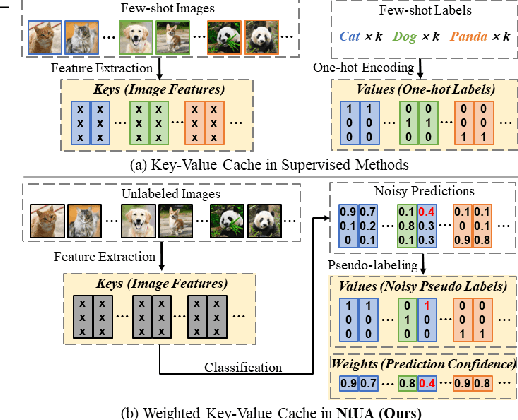Eman Ali
microCLIP: Unsupervised CLIP Adaptation via Coarse-Fine Token Fusion for Fine-Grained Image Classification
Oct 02, 2025Abstract:Unsupervised adaptation of CLIP-based vision-language models (VLMs) for fine-grained image classification requires sensitivity to microscopic local cues. While CLIP exhibits strong zero-shot transfer, its reliance on coarse global features restricts its performance on fine-grained classification tasks. Prior efforts inject fine-grained knowledge by aligning large language model (LLM) descriptions with the CLIP $\texttt{[CLS]}$ token; however, this approach overlooks spatial precision. We propose $\textbf{microCLIP}$, a self-training framework that jointly refines CLIP's visual and textual representations using fine-grained cues. At its core is Saliency-Oriented Attention Pooling (SOAP) within a lightweight TokenFusion module, which builds a saliency-guided $\texttt{[FG]}$ token from patch embeddings and fuses it with the global $\texttt{[CLS]}$ token for coarse-fine alignment. To stabilize adaptation, we introduce a two-headed LLM-derived classifier: a frozen classifier that, via multi-view alignment, provides a stable text-based prior for pseudo-labeling, and a learnable classifier initialized from LLM descriptions and fine-tuned with TokenFusion. We further develop Dynamic Knowledge Aggregation, which convexly combines fixed LLM/CLIP priors with TokenFusion's evolving logits to iteratively refine pseudo-labels. Together, these components uncover latent fine-grained signals in CLIP, yielding a consistent $2.90\%$ average accuracy gain across 13 fine-grained benchmarks while requiring only light adaptation. Our code is available at https://github.com/sathiiii/microCLIP.
DPA: Dual Prototypes Alignment for Unsupervised Adaptation of Vision-Language Models
Aug 16, 2024Abstract:Vision-language models (VLMs), e.g., CLIP, have shown remarkable potential in zero-shot image classification. However, adapting these models to new domains remains challenging, especially in unsupervised settings where labelled data is unavailable. Recent research has proposed pseudo-labelling approaches to adapt CLIP in an unsupervised manner using unlabelled target data. Nonetheless, these methods struggle due to noisy pseudo-labels resulting from the misalignment between CLIP's visual and textual representations. This study introduces DPA, an unsupervised domain adaptation method for VLMs. DPA introduces the concept of dual prototypes, acting as distinct classifiers, along with the convex combination of their outputs, thereby leading to accurate pseudo-label construction. Next, it ranks pseudo-labels to facilitate robust self-training, particularly during early training. Finally, it addresses visual-textual misalignment by aligning textual prototypes with image prototypes to further improve the adaptation performance. Experiments on 13 downstream vision tasks demonstrate that DPA significantly outperforms zero-shot CLIP and the state-of-the-art unsupervised adaptation baselines.
Noise-Tolerant Unsupervised Adapter for Vision-Language Models
Sep 26, 2023



Abstract:Recent advances in large-scale vision-language models have achieved very impressive performance in various zero-shot image classification tasks. While prior studies have demonstrated significant improvements by introducing few-shot labelled target samples, they still require labelling of target samples, which greatly degrades their scalability while handling various visual recognition tasks. We design NtUA, a Noise-tolerant Unsupervised Adapter that allows learning superior target models with few-shot unlabelled target samples. NtUA works as a key-value cache that formulates visual features and predicted pseudo-labels of the few-shot unlabelled target samples as key-value pairs. It consists of two complementary designs. The first is adaptive cache formation that combats pseudo-label noises by weighting the key-value pairs according to their prediction confidence. The second is pseudo-label rectification, which corrects both pair values (i.e., pseudo-labels) and cache weights by leveraging knowledge distillation from large-scale vision language models. Extensive experiments show that NtUA achieves superior performance consistently across multiple widely adopted benchmarks.
 Add to Chrome
Add to Chrome Add to Firefox
Add to Firefox Add to Edge
Add to Edge